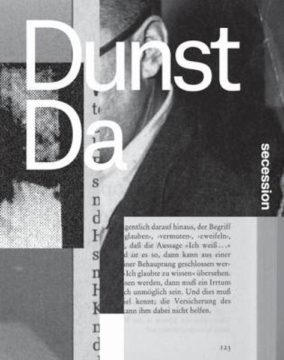Dunst’s conceptual approach is rooted both in the work of artists like Marcel Broodthaers who scrutinize the systems underlying the perception of words and images, and in the Viennese scene of the 1980s and its characteristic ambition to extend abstract painting into the exhibition space. He lends these complex issues fresh interest by developing forms into correlations and pointedly questioning the seemingly unequivocal meaning of the elements through variation, superimposition, and changes of direction.
In the Secession, the “D” and “A”, cut from pink foam material, lean at a wall that cuts diagonally through the main hall and functions as a bearer of a hypertext line. What happens if the letter objects are seen or read in their spatial context, if they develop themselves to a “da-vor” (there, in front of), “da-neben” (there, beside), “da-bei” (there, at), or “da-hinter” (there, behind)? This situation is further intensified by repeating the letters on the back of the wall, representing an alienation and reformulation of the front. There too, they are positioned in the middle so as to constitute a spatial axis. Even though they cannot actually be seen together, they move together in the memory. But how does the meaning of the “DA” change by reviving what has been written: do the letters become a hesitant stutter, or DADA, and thus refer to older forms of calling art into question? Deliberately and with great lightness of touch, Heinrich Dunst questions the unambiguousness of the references invoked. His sensing of semantic attributions oscillates between material and conceptual, between language and image, in order ultimately to reveal the preconditions inherent in art.
“Dunst’s work offers a precisely mediated and nuanced approach to the spaces and places it inhabits. The work is resolutely anti-authoritarian. Yet, unlike others, he doesn’t have to resort to expressionistic extremes to show his opposition to order for its own sake. His work can be calm and raw at the same time. His work can be textual and yet occupy the space of the painter at the same time. The work gently guides us through various perspectives and points of view while at the same time manipulating the speed and readings we may be able to make—from any ‘point of view’ and from his softly introduced ‘perspective’ at the same time. (Liam Gillick)
A large illustrated section designed by Walter Pamminger that applies the exhibition’s concept of the wall organizing both space and the perception of the individual elements according to a principle of recto and verso to the medium of the book.
- Veröffentlicht am Sonntag 16. Juni 2024 von Revolver Publishing
- ISBN: 9783957630117
- 112 Seiten
- Genre: Hardcover, Kunst, Softcover
